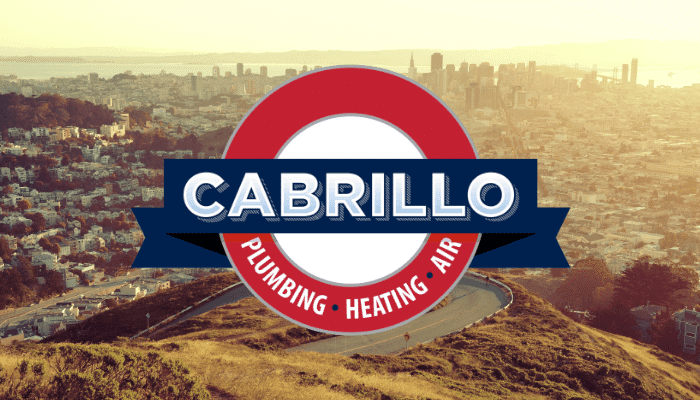
Here in the San Francisco area, we don’t see a lot of home air conditioning systems. We have to go down the Peninsula or over to the East Bay before we start finding them in every house. If you live in those areas that rely on air conditioning to keep you cool in the spring and summer, this article will point out some of the most common things that could go wrong with your system, and what you should do about it.
While all mechanical systems require repairs from time to time, many are preventable. In no particular order, here are the ten most common problems we encounter every Spring and what you can do to avoid them.
1. Tripped Breaker
One of the most common causes of no-cool calls is a tripped breaker. Reset it before calling us. Hopefully, it won’t repeat. If it does, call us. Something is causing the breaker to trip. Often, it’s something simple, like a bad breaker, loose wire, or a bad capacitor. However, if not addressed, some simple problems could lead to far more expensive repairs.
2. Dirty Filter
If you have a 1” disposable filter, it should be replaced monthly. It’s out of sight and out of mind, so it’s easy to forget to change it. Yet, every year we go on service calls where the air conditioner isn’t cooling and the cause is restricted air flow from an extremely dirty filter. Dirty filters reduce indoor air quality, make the home less comfortable, and can result in frozen indoor coils, eventually leading to serious repairs.
3. Refrigerant Leaks
An air conditioning system is a sealed system. It should never leak refrigerant. When it does, bad things happen. Your air conditioner efficiency falls and electricity use rises. Your air conditioner may not cool. The coil may freeze. The compressor could become damaged. Plus, refrigerants are greenhouse gases. We use a variety of tools to track down refrigerant leaks. Often the problem is as simple as a bad Schrader valve or a weakened connection between a fitting and refrigerant tubing.
4. Switch Turned Off
Some heating and air conditioning systems have a wall switch at the indoor unit for safety and convenience that can be confused with a light switch. If this is accidentally switched off or left off during mild weather, your air conditioner will not start. Always check the condition of this switch before calling us.
5. Thermostat Problems
Some thermostats must be switched between heating mode and cooling mode. If the switch is in the wrong position or breaks, your air conditioner won’t start. Quality digital thermostats rarely fail. Some of the cheap ones available from the big boxes might. So what goes wrong? The switch might break, a voltage spike might cause a malfunction, and so on.
6. Clogged Drain Line
Air conditioners pull moisture out of humid air while lowering the temperature. The moisture is typically drained out of your home through your plumbing system. A drain pan should be present as a back up with a secondary condensate drain. Algae can grow in these lines, clogging them up. This can lead to water damage in your home. We clear the drain lines as part of our Spring air conditioning tune-up or you can have it done separately, as needed.
7. Contactor
A contactor is an electromechanical switch in your air conditioner. Sometimes the coating on a contacts will wear off and the contactor will stick, causing the outside unit to run continuously, which is expensive. Sometimes ants are attracted to the electricity and get squashed between the contacts, blocking them from closing. When this happens, the outside unit won’t run. Contactors can also fail electrically. We check these as part of a Spring tune-up, clean the surface of the contacts if needed, and recommend replacement if failure appears imminent.
8. Dirty Evaporator Coil
The evaporator coil is located inside your home. Liquid refrigerant is sprayed into this coil to evaporate and draw heat from the air being blown across the coil. Periodically the coil needs to be cleaned or dust and particle build up will restrict the coil’s heat transfer capabilities and reduce system air flow down the duct system. Dirty coils increase operating cost while simultaneously reducing home comfort.
9. Dirty Condenser Coil
The condenser coil is located outside your home. The compressor pulls hot refrigerant gas from the evaporator and pumps it through the outdoor coil where it condenses into a liquid as the condensing unit fan pulls air across the coil. A dirty or restricted coil is inefficient, increasing electricity usage and reducing system cooling capacity. We wash, clean, and if needed, comb the condenser coil as part of the Spring tune-up.
10. Duct Leaks
Your heating and air conditioning system adds and removes heat to the duct system. The duct system is tasked with delivering it to the occupied areas of your home. If the ducts that supply conditioned air to the living space leak and are located outside of the living space, you’re essentially paying to heat or cool the outdoors. If the ducts that return conditioned air from the living space leak, you pull in unconditioned, unfiltered air. Duct leakage is one of the leading causes of inefficient air conditioning operation and home comfort problems. Leaks range from duct penetration to split seams to completely disconnected ducts. Repairing individual leaks is not expensive. It’s the leaks that are expensive.
